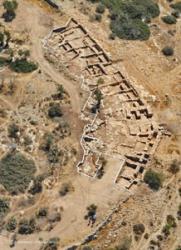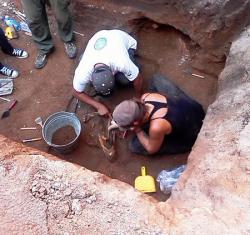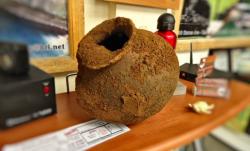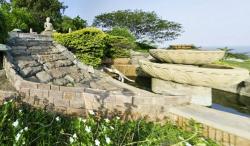24 JANVIER
INDI-UNI : ANTHROPOLOGY - ARCHAEOLOGY
INSCRIPTION 2012 COURS A DISTANCE
REGISTRATION 2012 ONLINE COURSES
ISRAEL –  Khirbet Qeiyafa - Final aerial photos from the end of the 2011 excavation season at Khirbet Qeiyafa were posted to the project’s official Web site this week. The images give stunning views of the site’s various excavation areas, including the now well-defined area of the site’s southern four-chambered gate and adjacent casemate walls and fortifications (pictured). As reported in BAR, Khirbet Qeiyafa is a small but imposing fortress on the border between Judah and Philistia that has been dated by pottery and radiocarbon analysis to the early tenth century B.C.E. and the reign of King David.
Khirbet Qeiyafa - Final aerial photos from the end of the 2011 excavation season at Khirbet Qeiyafa were posted to the project’s official Web site this week. The images give stunning views of the site’s various excavation areas, including the now well-defined area of the site’s southern four-chambered gate and adjacent casemate walls and fortifications (pictured). As reported in BAR, Khirbet Qeiyafa is a small but imposing fortress on the border between Judah and Philistia that has been dated by pottery and radiocarbon analysis to the early tenth century B.C.E. and the reign of King David.
http://www.biblicalarchaeology.org/daily/news/new-images-from-khirbet-qeiyafa-excavations/
BELIZE – 
 San Ignacio - Construction workers laying new pipes and cables on Burns Avenue in San Ignacio in western Belize have stumbled upon a cache of Maya artifacts dating back more than 2 thousand years. The pottery and human bones were unearthed during work that is part of a $2.7 million dollar beautification project in the small town. The area is home to the nearby Cahal Pech Maya Site. “What we have here are three jars or ollas as they call them in Spanish and by the style of it, by the way they were made we know that they date to the late Pre-classic period or between 300 BC to about the birth of Christ so over 2000 years old. The type of artifacts that we are finding indicates household, not elite, not the rulers, they lived closer to downtown Cahal Pech Maya Ruin. This summer for instance we found this amazing tomb up at Cahal Pech that is where the wealthy and the real elite people lived. Out here the common folks like me and you. We are in the suburbs of Cahal Pech. A lot of times people think you go to Cahal Pech and that is all the site, that is downtown but the rest of the ancient city of Cahal Pech extended all the way to where the two rivers meet, across into Santa Elena, towards Bullett Tree Falls. It was a big community so these objects were found in one of the houses that belonged to that ancient city.”
San Ignacio - Construction workers laying new pipes and cables on Burns Avenue in San Ignacio in western Belize have stumbled upon a cache of Maya artifacts dating back more than 2 thousand years. The pottery and human bones were unearthed during work that is part of a $2.7 million dollar beautification project in the small town. The area is home to the nearby Cahal Pech Maya Site. “What we have here are three jars or ollas as they call them in Spanish and by the style of it, by the way they were made we know that they date to the late Pre-classic period or between 300 BC to about the birth of Christ so over 2000 years old. The type of artifacts that we are finding indicates household, not elite, not the rulers, they lived closer to downtown Cahal Pech Maya Ruin. This summer for instance we found this amazing tomb up at Cahal Pech that is where the wealthy and the real elite people lived. Out here the common folks like me and you. We are in the suburbs of Cahal Pech. A lot of times people think you go to Cahal Pech and that is all the site, that is downtown but the rest of the ancient city of Cahal Pech extended all the way to where the two rivers meet, across into Santa Elena, towards Bullett Tree Falls. It was a big community so these objects were found in one of the houses that belonged to that ancient city.”
Read more: http://belizean.com/construction-workers-find-maya-artiefacts-under-street-in-belize-1001/#ixzz1kOlnhlyd
INDE –  Thotlakonda - The All India Lay-Buddhist Organisation (AILBO) and the Forum for Better Visakha (FBV) have decided to move the court against the government order transferring around three acres of Thotlakonda Buddhist site to the Indian Navy to construct a 60 feet road making a passage to its own site of around 100 acres beyond Thotlakonda. The Thotlakonda Buddhist site is a protected monument on the Bheemili beach road, about 15 km from Visakhapatnam. The monument is located on the top of a hill. The site spreads over an area of around 600 acres . Incidentally, it is the Indian Navy which discovered the Thotlakonda Buddhist site during the aerial survey conducted for setting up the Naval base in Visakhapatnam. The archaeology department carried out major excavations at the site between 1988 and 1993. The excavations uncovered three kinds of structural remains--religious, secular and civil. The structures include a mahastupa, 16 votive stupas, a stone pillared congregation hall, 11 rock-cut cisterns, well-paved stone pathways, an apsidal chaitya-griha, three circular grihas, two votive platforms, 10 viharas, a kitchen complex with three halls and a refectory (dining hall). Apart from the structures, the Buddhist treasures unearthed include nine Satavahana and five Roman silver coins, terracotta tiles, stucco decorative pieces, sculptured panels, miniature stupa models in stone, Buddha padas with asthamangal symbols and early historic pottery.
Thotlakonda - The All India Lay-Buddhist Organisation (AILBO) and the Forum for Better Visakha (FBV) have decided to move the court against the government order transferring around three acres of Thotlakonda Buddhist site to the Indian Navy to construct a 60 feet road making a passage to its own site of around 100 acres beyond Thotlakonda. The Thotlakonda Buddhist site is a protected monument on the Bheemili beach road, about 15 km from Visakhapatnam. The monument is located on the top of a hill. The site spreads over an area of around 600 acres . Incidentally, it is the Indian Navy which discovered the Thotlakonda Buddhist site during the aerial survey conducted for setting up the Naval base in Visakhapatnam. The archaeology department carried out major excavations at the site between 1988 and 1993. The excavations uncovered three kinds of structural remains--religious, secular and civil. The structures include a mahastupa, 16 votive stupas, a stone pillared congregation hall, 11 rock-cut cisterns, well-paved stone pathways, an apsidal chaitya-griha, three circular grihas, two votive platforms, 10 viharas, a kitchen complex with three halls and a refectory (dining hall). Apart from the structures, the Buddhist treasures unearthed include nine Satavahana and five Roman silver coins, terracotta tiles, stucco decorative pieces, sculptured panels, miniature stupa models in stone, Buddha padas with asthamangal symbols and early historic pottery.
http://ibnlive.in.com/news/furore-over-buddhist-site-given-to-navy/223767-60-114.html
ROYAUME UNI - Newcastle - Times may seem tough in the current economic squeeze but a city centre dig suggests that our Tyneside ancestors had rather more to bleat about. Two arches of the High Level Bridge, opposite the Bridge Hotel in Newcastle, have been investigated by archaeologists. They were called in after preliminary boreholes in advance of renovation work on the arches produced finds of sheep bones. The dig uncovered more sheep remains, plus the bones of cows, pigs, fallow and roe deer, birds, fish and small animals. The arches stand near what was known as Sheep’s Head Alley, the remnants of which still run behind the beer garden of the Bridge Hotel. “The name of Sheep’s Head Alley may have been given due to poor post-medieval residents boiling up sheep heads, discarded by the butcher, to eat,” said Jon Welsh of AAG Archaeology, which carried out the dig. One of the deer bones had knife marks from skinning and filleting. “They could have been hunting deer in medieval times outside the town walls,” said Jon. The dig also revealed the remains of the workshop of Robert Beall, a monumental sculptor and marble mason, which occupied the area from 1861.
http://www.journallive.co.uk/north-east-news/todays-news/2012/01/24/archaeological-dig-at-high-level-bridge-reveals-secrets-61634-30185755/